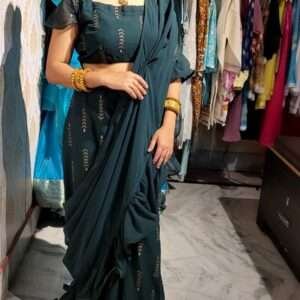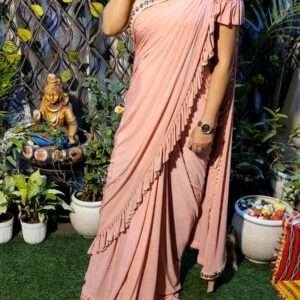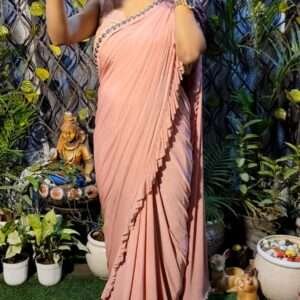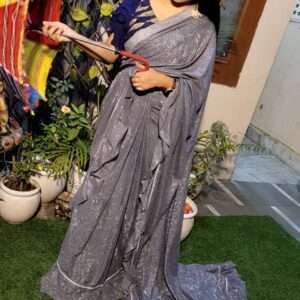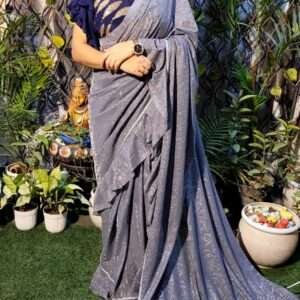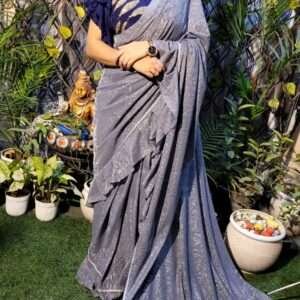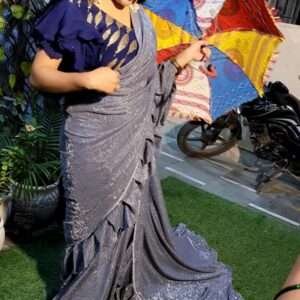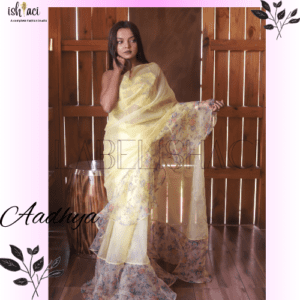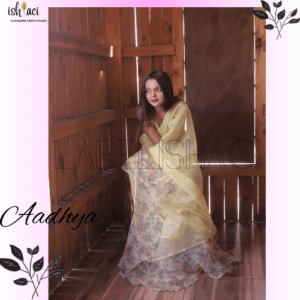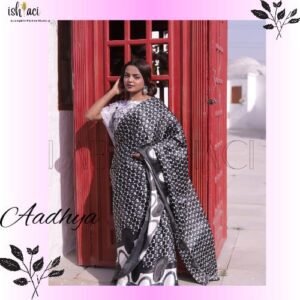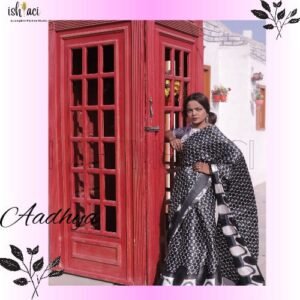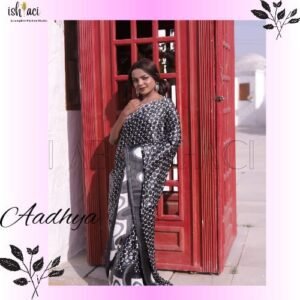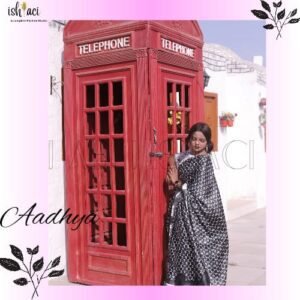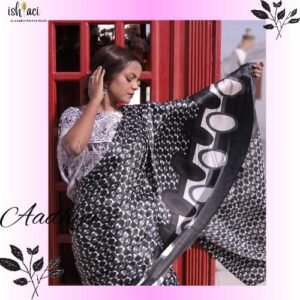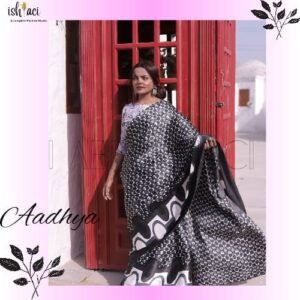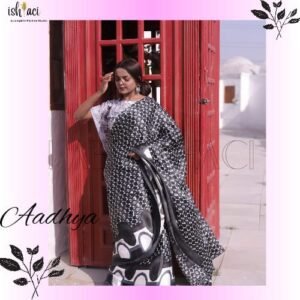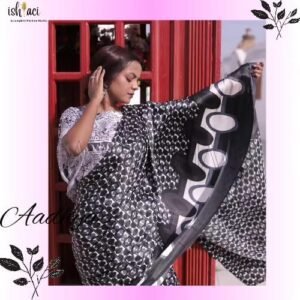Featured Products
"Sarees: A Timeless Tale of Elegance and Tradition"
Exploring the Diverse Styles and Patterns of Sarees in India
India is the melting pot of cultures, traditions, and clothing with saree always standing as a mark of grace and elegance. The drapery stands unique for every different corner of the country, binding in their rich tradition and their art in the style of the outfit and its pattern. From the famed opulence of Uttar Pradesh’s Banarasi to the lively Bandhani of Gujarat and the elegant Kanjeevaram of Tamil Nadu, each type tells its own story about where it has come from.On this occasion, let’s make a journey around India to look at these distinguished saree styles and patterns, celebrating the beauty and diversity of Indian textile art.
## Northern India
### Banarasi Saree (Uttar Pradesh)
Meant to be special and absolutely stunning, Banarasi sarees are one of the most well-known pieces to come out of Uttar Pradesh. Their rich embroidery, elaborate patterns, and sensuous silk fabric make them the essential wear for a wedding or celebration. In general, the main part of a Banarasi sari is usually dominated by Mughal designs characterized by stylized flowers, jhallar and leaves. A Banarasi sari is timeless and esteemed since, it is considered as an invaluable treasure with great regional cultural richness.
### Phulkari Saree (Punjab)
Phulkari sarees, which originate from Punjab, work together with other textiles to say much more about Punjab culture. The whole body of Khadi cloth clothing has this phulkari traditional thread work and also flowers embroidered on it. This energetic Punjab is symbolized by varied colors marked by flowered motifs or unique geometrical designs shall then be used to define these designs. A Phulkari saree is nothing less than a piece of artistic work reflecting the expertise and cultural richness of the region. People who love traditional Indian clothing cherish these sarees because they have very lovely colors and patterns.
### Pashmina Saree (Jammu and Kashmir)
Pashmina sarees from Jammu and Kashmir are renowned for their luxurious softness and warmth. Made from fine cashmere wool, these sarees often feature intricate embroidery known as ‘kani’ or ‘sozni’, depicting floral and paisley motifs.
## Eastern India
### Tant Saree (West Bengal)
Tant sarees are originally from West Bengal, which is a region that experiences high temperatures concurrently with high humidity levels. These sarees usually have thick borders, and their pallus are also well embroidered with attractive designs of flowers, leaves and paisleysTheir transparent texture and lively decoration have made them quite prevalent among users for daily wear or even festive occasions.These tant sarees don’t only provide comfort but they also reflect a great number of craftsmanship visible through artistic expressions in the region hence it is also a rich cultural heritage of West Bengal.
### Baluchari Saree (West Bengal)
ng of Baluchari comes from the West Bengal, India. It draped women in its rich pallus bearing legends, myths and other stories from traditional clothing cultures including those about style history or politics. Those made colourful ones using silk always tell tales specific to their designs or patterns while still maintaining some kind of uniqueness among all other types within society today.Most often, the elaborate pallu designs depict scenes from the epics and folklore, which add a timeless elegance to the Baluchari sarees.Baluchari sarees encompass what could be termed as design finesse and artistic perception, an epitome of the elegance of Bengali tradition and work of art finesse.
Sambalpuri Saree (Odisha)
The Sambalpuri sari is essentially an Orissa hand-woven sari using the traditional bandha ikat technique. These add to the richness of the flora and fauna decoration elements. Geometric designs commingle with nature imagery to display the cultural heritage and aesthetic skills of Odisha. Sambalpuri sarees contain intricate patterns that narrate the tale of where they originated from in Odisha, hence symbolizing rich traditions and expert workmanship. The garment is treasured for more than the intricate designs- it is a product of careful weaving which reflects various customs of the region.
### Mekhela Chador (Assam)
With natural elements on it such as birds, flowers or animals which help in representing its incredible environment, this traditional two-piece outfit that people wear as their dress code in Assam is called the Mekhela Chador. The material used to make this outfit is silk hence making it appear magnificent due to various lovely designs like flowers or animals that resemble what exists within the specific areas within the country.The Mekhela Chador bears a lot of relevance within the traditional gamut of an Assamese cultural ethos and is worn with pride by women during festivals, marriages, and other important events. Not only do the designs of the Mekhela Chador shriek out loud in the beauty Assam is adorned with, but it also speaks volumes for the artistic heritage and the people’s skill in craftsmanship in Assam. Each Mekhela Chador is another proof of Assam being a land of rich cultural diversity and of the eternal grace of its traditional attire.
## Western India
### Bandhani Saree (Gujarat and Rajasthan)
Bandhani, known also as Bandhej, signifies the vibrant colours present in the two states of Gujarat and Rajasthan. It has splendid patterns in various colours which make it beautiful; however the yarn colours used are shining with beautiful patterns unique to this art. This process of designing cloth whose origin is dated back to many years ago chiefly involves joining unnoticeable points on the cloth material with strings before dying; other figures like dots, squares or waves are also added in order to make different shapes. A bandhani saree is not just an attire – it is a legacy of creativity and tradition, hence every fold is full of happiness and vitality; as such each piece is an exquisite homage to conventional beauty and craftsmanship in that particular part of the country.
### Patola Saree (Gujarat)
Originating from the state of the Gujarat, Patola Sarees are truly the epitome of traditional talent and hard work of craftsmen. These are the only type of sari in the world with double ikat woven fabrics. Each of these sarees is known for its intricate and lively designs and their complex patterns and rich colours easily compete with popular Indian auctions. Each Patola saree was painstakingly woven with rich detailing and vibrant colors over many years or months of time, making them so highly priced and usually passed down as cherished heirlooms from one generation to the next. Wearing a Patola saree brings honor and dignity as well as the grandeur of the ancient textile tradition of Gujarat.
### Paithani Saree (Maharashtra)
Paithani sarees are luxurious silk sarees from Maharashtra, known for their peacock motifs and intricate designs. Sarees frequently have bright colors with gold and silver threads in their weave, resulting in a dense, carpet-like look.
## Southern India
### Kanjeevaram Saree (Tamil Nadu)
Kanjeevaram from Tamil Nadu boasts luxurious silken cloth and fine workmanship. Broad contrast borders lend even a touch of grandeur to the elegance of these sarees.“Handwoven Kanjeevaram silks are an incredible blend of Indian tradition and beauty. These sarees come with intricately designed temple motifs, paisleys and peacocks that are all made from shiny gold or silver yarns reflecting all the timelessness associated with Kanjeevarams.”. One of the most popular choices as bridal wear in south India, Kanjeevaram sarees are symbolic of tradition, elegance, and richness. Every Kanjeevaram saree is a masterpiece of art and heritage of the Tamil Nadu people and would be close to the heart of everyone who possesses it and wears it on special occasions.
### Kasavu Saree (Kerala)
Kasavu saris are always dear to women in the state of Kerala, having an air of tradition and grace, especially at all occasions and weddings. White or cream cloth with a golden line at the border is considered a classic—a mark of simplicity and prestige. Kasavu saris in general are designed very minimally with small golden designs to capture the very core of Kerala’s cultural heritage with a sari that is just so graceful. Wearing a Kasavu sari is more than just dressing; it is a tradition across generations. It is a proud and respectful gesture toward the rich cultural heritage of Kerala, bringing nostalgia and belonging with every sari on the person wearing it.
### Mysore Silk Saree (Karnataka)
The Mysore Silk Sarees hail from the state of Karnataka and are popular for their rich feel and their shimmering shine. Made from pure silk, these sarees provide a very touchy, smooth feel, just like drifting over the skin. Mysore silk sarees epitomize understated chic, with very delicate designs and little embellishments. They are adorned with classic gold zari borders that are rich in intricacy and give off a timeless charm, befitting any occasion with a touch of sophistication.There is no experience that compares to wearing a fabric woven from Mysore silk in Indian State of Karnataka.
### Pochampally Saree (Telangana)
Telangana state is the birthplace of Pochampally sarees which are world known for their classic hand woven designs. Pochampally sarees have very attractive linear patterns and are brightly colored thus representing Telangana’s rich cultural spiritland. Each individual saree in India bears testimony to distinctiveness of workmanship and care lavished on it by artisans.. To wear a Pochampally saree is to embody something far more powerful than a mere piece of cloth.Each fold signifies the centuries-old savoir-faire and celebrates the artistic genius of this region..
## Central India
### Chanderi Saree (Madhya Pradesh)
Chanderi sarees have originated from the state of Madhya Pradesh and people love them for their delicate texture and feather-light feel. Made from silk, cotton, and zari intermixed with each other, the fabric is best known for both exquisiteness and comfort. Chanderi sarees, with motifs of peacocks and flowers and geometrical designs, speak of an ageless yet contemporary elegance which lends sophistication to any festive event. Chanderi sarees are not just another fabric laid on the human body; they contain a tradition of exquisite craftsmanship and artistic acumen that has nurtured the state of Madhya Pradesh for generations and celebrates its cultural milieu with every drape.
### Maheshwari Saree (Madhya Pradesh)
Coming from Madhya Pradesh, Maheshwari sarees are known for their timelessness and versatility. Elegant stripes and checks, along with floral borders, have a very subtle charm in them that not only adorns but offers a tone to wear anywhere, during work time or at a party. Maheshwari sarees give a rich look with the feel of silk and comfort of cotton because they are made out of fine silk and cotton. Their lightness endears them to women, who can effortlessly drape and move in them with ease.Maheshwari sarees are all about wearing a tradition that is made out of elegance instead of just cloth arranged in simple folds.
## Northeastern India
### Muga Silk Saree (Assam)
Muga silk sarees originated from Assam and are mostly famed for being strong, too glossy or smooth in body type without looking slippery; they’re made out of Antheraea assamensis that can only be found in the state.. The Muga silk fabric displays regional textile history through Assamese styled designs such as flowers, animals, and geometrical shapes.- Every Muga silk saree speaks a story from the land from it originates. It’s not simply a matter of dressing in a Muga silk saree; it is embracing a piece of Assam’s cultural heritage that is epitomized by the highest form of fine craftsmanship and manual dexterity which has transcended borders.



